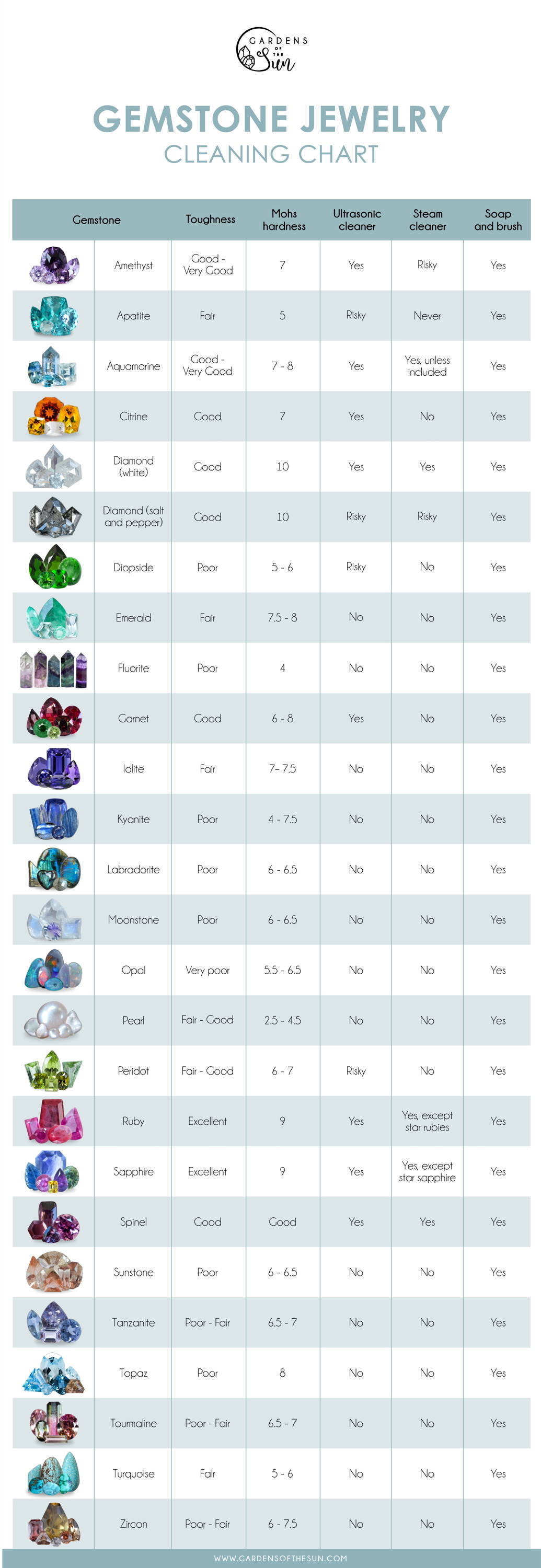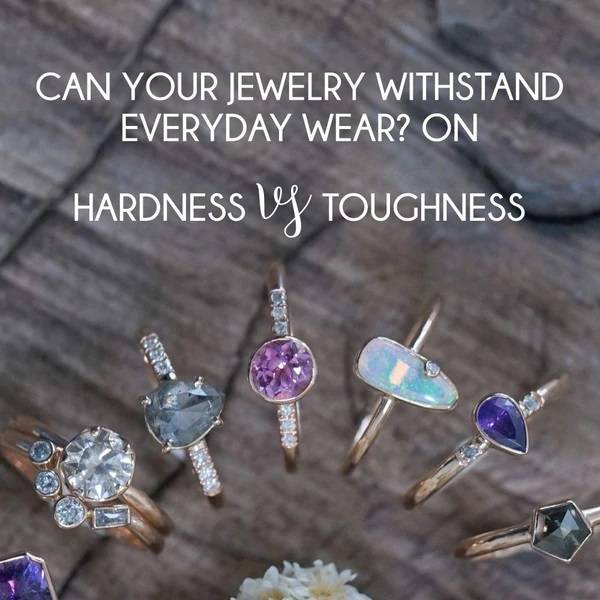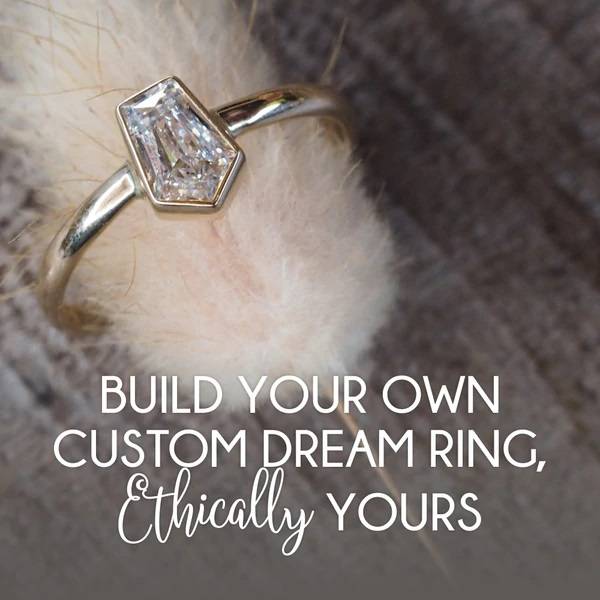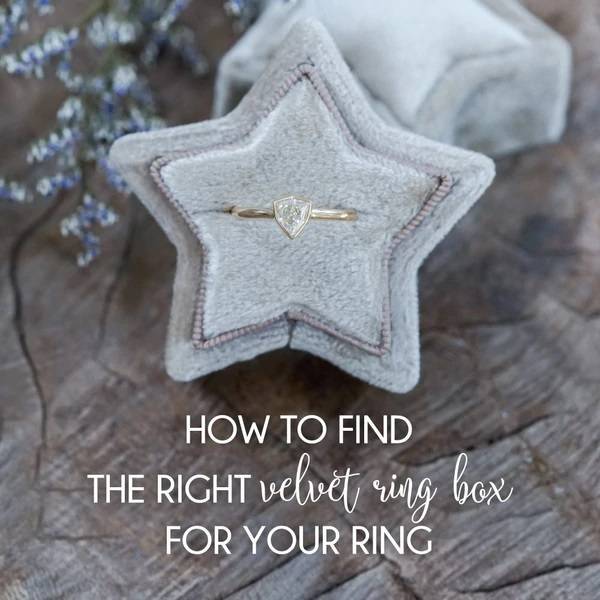Your Cart is Empty
The safest way to clean your gemstone jewelry
Ever wanted to turn back the clock on your gemstone jewelry? Have it sparkling like new again? Trust me, it’s relatively easy to get that sparkle back.
Google ‘how to clean my jewelry at home’ and you’ll find yourself on Amazon for an ultrasonic cleaner or steam cleaner a minute later. Although it takes only a few minutes to clean your jewelry by pressing a button, there are downsides to these cleaners. There are gemstones you should NEVER put in an ultrasonic cleaner or steam cleaner.
The best way to clean your jewelry? Water and mild soap.
But before we get into why ultrasonic cleaners aren’t our preferred option, let’s find out what ultrasonic and steam cleaners actually are.
Cleaning your jewelry with ultrasonic cleaner

Ultrasonic cleaners use high frequency ultrasound waves to create microscopic bubbles in the water. These bubbles can reach every nook and cranny in your jewelry.
Ultrasonic cleaners are small in size and look similar to a rice cooker. It’s as simple as adding water into the cleaner, dipping your jewelry into the water, and turning it on to activate the ultrasound wave. You may want to add a cleaning solution for an even more effective deep cleanse.
You don’t see this wave making visible ripples, but its tiny vibrations are abrasive enough to clean away dirt and grime. It’s not meant to remove tarnish if your silver jewelry is turning black.
Soft gemstones, like opal, pearl, moonstone and turquoise can’t withstand ultrasonic cleaners. Heavily included gemstones, like salt and pepper diamonds and emeralds (a naturally included gemstone often treated with oil to fill internal cracks) should not be cleaned with an ultrasonic cleaner. The ultrasonic vibrations can affect internal flaws and crack the stone. Some ultrasonic cleaners heat the water up to 80°C. This can damage gemstones vulnerable to heat or temperature changes, like opal.
The downside to ultrasonic cleaners is that those high frequency waves so effective in reaching the tiniest can loosen the gemstone in the setting. If you choose this method, be sure to check the setting of your jewelry after each wash.
Suitable for:
Plain metal rings, like your wedding band
Jewelry with engraving or texture
Cleaning multiple pieces of jewelry at a time
Watches, keychains, coins, etc.
Never put these in an ultrasonic cleaner:
Heavily included gemstones and diamonds (this includes salt and pepper diamonds)
Amber, emeralds, fluorite, iolite, jade, kunzite, kyanite, labradorite, lapis lazuli, moonstone, opals, pearls, sunstone, tanzanite, topaz, tourmaline, turquoise and zircon
Inlay jewelry
Filigree jewelry
Cameo jewelry
Foil backed stones
Duration:
Less than 10 minutes
Eco friendly:
Relies on high frequency ultrasound, not necessary to add any cleaning solution
A lot of energy, metals and minerals are used to manufacture an ultrasonic cleaner
Needs electricity to run
Price:
US $30-$100. Cheaper than a steam cleaner.
Difficulty:
Easy
Check your stone setting for tightness after each and every clean
Cleaning your jewelry with steam cleaner
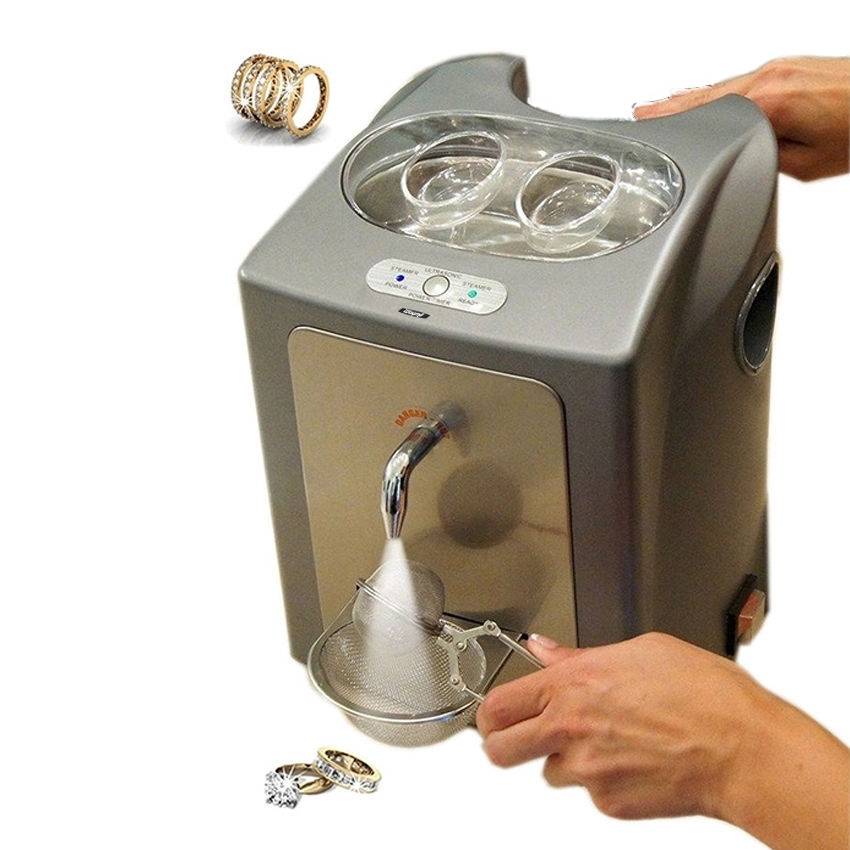
A steam cleaner uses high pressure steam to blast away dirt. It’s a quick and easy method, and similar to an ultrasonic cleaner, it uses water rather than harsh chemicals to do its job. It uses water’s amazing property - to break down into super tiny particles within a few seconds - to penetrate into the tiniest spots.
The risk with steam cleaners is thermal damage. Since steam cleaners are basically boiling hot water, your metals and gemstones will be exposed to drastic temperature change. You can clean your jewelry within seconds with steam cleaners, but your jewelry must be able to withstand high heat.
Avoid cleaning jewelry with included gemstones with steam cleaners. Since included gemstones mean the host stone contains different minerals (the inclusions), under high heat, the two minerals can react differently to heat, causing fractures or internal cracks.
Plus, high pressure steam is harsh AF. Soft gemstones may break under its pressure.
Suitable for:
Plain metal rings, like your wedding band
Jewelry with engraving or texture
Jewelry with a diamond, sapphire or ruby
Cleaning multiple pieces of jewelry at a time
Keychains and coins
Never put these in an ultrasonic cleaner:
Heavily included gemstones and diamonds (this includes salt and pepper diamonds)
Amber, emeralds, fluorite, iolite, jade, kunzite, kyanite, labradorite, lapis lazuli, moonstone, opals, pearls, sunstone, tanzanite, topaz, tourmaline, turquoise and zircon
Inlay jewelry
Filigree jewelry
Cameo jewelry
Foil backed stones
Duration:
Few minutes to heat the water and a few seconds to clean the jewelry
Eco friendly:
It uses only water
A lot of energy, metals and minerals are used to manufacture a steam cleaner
Needs electricity to run
Price:
Around US $100
Difficulty:
Easy
Watch out for hot water
Why we don’t recommend using an ultrasonic or steam cleaner
Automatic cleaners are great only for precious gemstones without internal flaws, fractures or inclusions. If your gemstones were treated (hint: most rubies and sapphires on the market are), heavily included (like salt and pepper diamonds) or if you have a soft gemstone like opal, ultrasonic and steam cleaners can damage the gemstones in your jewelry. Heat, vibration, and pressure are not gems’ bestfriends. Even for the setting, these harsh cleaners can loosen this tiny metal grip and expose your gemstones. After several washings, the gemstones might come off the setting.
To make it even more complex (and terrifying), unless you’re a gemologist or experienced with gemstones, it’s almost impossible to tell the quality of your gemstone’s internal structures.
But the good news is:
cleaning your jewelry isn’t that complicated! In fact - for most gemstones, including treated and included gemstones, the best method for cleaning is warm water, a few drops of mild soap and a soft brush. Here’s how.
Cleaning your jewelry with warm water and mild soap
Mild soap can be a gentle dishwashing soap, baby soap, or a gentle hand and body soap.
If you’re not sure, use soap nuts, which grow abundantly in tropical and subtropical climates. Soap nut is traditionally used to clean anything from laundry to cutlery; from your head to toe. It bubbles like soap, making water more ‘slippery’, allowing it to penetrate deeper into the nooks and crannies. It’s also soft and safe enough to clean metals and gemstones.
If your silver is heavily tarnished, you can add baking soda for a more aggressive wash.
For tight corners with grimes, use a soft brush (a toothbrush offers good grip and good size bristles) and brush gently. Pat the jewelry dry and leave it to air dry. That’s it! As simple as washing your hands and therapeutic enough to turn it into a Sunday morning ritual.
Now the question is - if it uses natural soap, does it mean you can clean it often? Not quite! Soap itself as well as the physical brushing is still abrasive contact over time. Once every 6 weeks should be sufficient, or depending on wear, tear and storage.
Once you see a visible build up, make time for cleaning. The key for a sparkling clean gemstone is to clean it every now and then, not after your ring goes grinch and unrecognizable.
If you bring your jewelry to a professional cleaner, make sure they’re aware of the internal condition of your gemstone. Remember not all jewelry cleaners are jewelers who understand the chemical structures of your gemstones. If you’re feeling doubtful about their knowledge of gemstones - leave.
Suitable for:
Jewelry with engraving or texture
Almost everything, from hard rock like diamond to soft organic stones like pearl
Vintage or antique jewelry
Filigree jewelry
Inlay jewelry
Duration:
Around 10-15 minutes
Eco friendly:
Depends on the soap you use! Use natural soap to make sure you’re not dumping unnecessarily harsh chemicals into the ecosystem.
Price:
Cheapest of all
Difficulty:
Medium
These problems will require professional help
Rhodium plating
For proud owners of white gold jewelry, the white shine of rhodium plating will fade over time. But don’t fret - this actually happens over many years since rhodium is a pretty damn strong metal which protects and increases the luster of your ring. When you begin to see yellow shine peeking through, it’s time for replating.
Scratched gemstone or metal
If you see tiny scratches on the gemstone or metal, the only way to bring back its luster is to re-polish it. Repolishing is like having your body scrubbed. It lifts off ‘dead skin’ or the outermost layer of gemstone, leaving a fresh, pristine layer underneath. It’s an easy way to bring back the shine - if you have the right tools.
Loose prong setting
If you notice the gemstone moving its setting, however slightly, it’s time for a visit to your jeweler. This typically happens to prong settings where the prong has worn down after years of use. The grip or the claw might have become flattened, thinner, or even bent.
Loose setting often happens on jewelry with higher amounts of gold or silver. This is because gold and silver are soft metals.
Like any other precious possessions, jewelry does require maintenance. But I hope this blog post helps you choose the right cleaning method for your gemstone jewelry.












